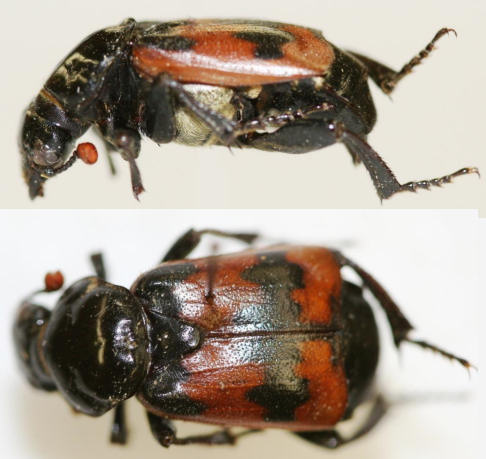 |
TAXONOMY Kingdom Animalia Phylum Arthropoda Class Insecta Order Coleoptera Family Silphidae Genus Nicrophorus Species Nicrophorus marginatus Common Name Margined Burying Beetle |
Identification
The burying beetle Nicrophorus marginatus possesses a six-segment antenna, with the terminal clubbed lamellar antennomere colored orange. The elytra is short, leaving the last three segments of the abdomen, which are often covered by hair, exposed. Members of the Nicrophorus genus can be distinguished among other members of the Silphidae family by their antennae, the black body with two wide orange-red colored bands running across the elytra, and strong mandibles for cutting, burying, and tearing decaying flesh. Some burying beetles look similar to N. marginatus, like N. investigator (which develops more hair structures on the ventral part of the mesothorax through part of the abdomen) and N. vespillo (found in England).
Natural History
Behavior of the burying beetle
Also known as the sexton beetle, this insect can be considered one of "nature's scavengers and cleaners" (Ewald Reiter, 1960). Nicrophorus marginatus feeds on small carrion; that is why not many small carcasses on the countryside can be seen. Besides having the carrion as part of their diet, the burying beetle male uses it to attract the female and create a nest for their offspring. First, it locates the carrion by its keen sense of smell on the antennae. There may be more than one male at the location, so they must fight each other, and only the strongest will prevail. Even if two males stay, only one will have the chance to mate with the female, and the other burying beetles must fly away in search for another carcass. The male burrows underneath the carrion and excavates beneath it, using its strong mandibles to cut off any roots or weeds in the soil. In just minutes, the carrion descends into the pit, while the burying beetle shapes it into a ball and removes the hair or feathers from the carcass, leaving a burrow to the surface. The burying beetle leaves a hollow space with an entrance and waits for a female to arrive. Once the female yields to the male's courtship, they copulate. The male is forced to leave after the female lays the eggs and eats her first meal in the chamber. In some cases, the male stays outside to protect and defend the brood from other insects that may arrive to parasitize or colonize.
Parental Care
Most of the members of the Nicrophoruss genus, like some other insects in general (i.e., Dermapterans), are distinguished by providing care to their offspring. In the case of the burying beetle, the female remains in the nest until the offspring are able to feed by themselves prior to entering pupation. Five days after the female burying beetle lays approximately six eggs, the larvae hatch and drink a brown liquid made by regurgitated meat dripping from a depression prepared on top of the chamber. Five days later, the larvae are able to feed by themselves from the carrion.
Development
Before pupation, the larvae of the burying beetle undergo several different larval stages, called instars. The first stages are similar to those of any other members of the Silphidae. The following stages are more like those in the Staphylinidae family. During the last stage, the larvae develop short legs, representing a hypermetamorphosis (when the larval instars go through two or more different forms before entering pupation). Once the burying beetles complete their pupation stage they emerge to the surface of the nest.
Habitat and Distribution
Different species of Nicrophorus are widely distributed throughout the world, such as in North America (Nicrophorus americanus) and Mexico (Nicrophorus mexicanus), as well as England (Nicrophorus vespillo) and other countries in Europe. Nicrophorus marginatus can be found in central North American territories, like South Dakota, Nebraska, Kansas, Oklahoma, and parts of Texas. Preferred habitats include oak and hickory forests, grassy prairies, and rural areas. In El Paso, Texas, the specimen pictured above was found in the Lower Valley, in the Socorro area near cotton fields and an irrigation canal.
Effects on the Ecosystem
Members of the Nicrophorus genus are not considered pests. These insects help out in cleaning the environment by reducing the decaying odors of dead animals by burying them, and secondly by eating the carcass before other insects, such as flies (Dipterans), can use the source for their reproductive needs. Although their preference is carrion as their main food source, there are related species from the Silphidae carrion-beetle family that are pests on crops in the United States as well as in other countries. One of them is the Blitophaga opaca (beet carrion beetle in Europe), which is a pest on beets, and Silpha americana (America), a pest on sugar beet, spinach, and pumpkin.
References
Anduaga, Sofia, and Carmen Huerta. Effect of Parental Care on the Duration of Larval Development and Offspring Survival in Nicrophorus mexicanus. The Coleopterist Bulletin, pp. 264-270.
Began, Michael, John L. Harper, and Collin R. Townsend. Ecology: Individuals, Populations, and Communities. Gov. Docs. Federal I 49, 2:B39.
Haarstad, John A. Insects of Cedar Creek, Cedar Creek National History Area (cedarcreek.umn.edu).
Harnett, Ross H. 1960. The Beetles of The United States, a Manual for Identification. Washington, Catholic University of America Press, Washington, D.C.
Koulianos, S., and H. H. Schwarz. Probability of Interspecific Encounters, and the Duration of Parental Care in Nicrophorus investigator. Annals of the Entomological Society of America, pp. 836-840.
Reiter, Ewald. 1960. Beetles. New York, Putnam Press, New York, 205 pp.
Rintoul, David A., Laura M. Krueger, Chari Woodard, and James E. Thorne. 2005. Journal of the Kansas Entomological Society, pp. 124-133.
Winkler, Josef R. 1964. A Book of Beetles. Spring Books, London, 150 pp.
This webpage was created by Kory Kohlhoff and Ivan Solis in partial fulfillment of Entomology, 2007, University of Texas at El Paso. The views in this webpage are based on our research and may not reflect the views of the University of Texas system.